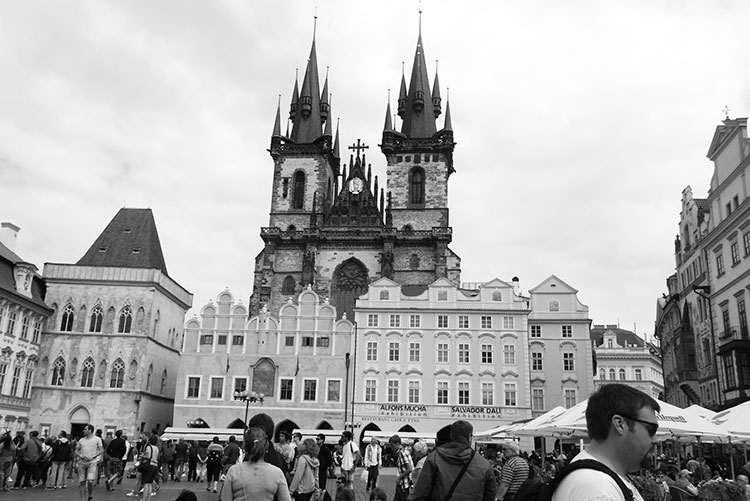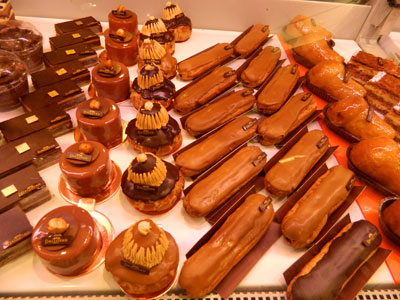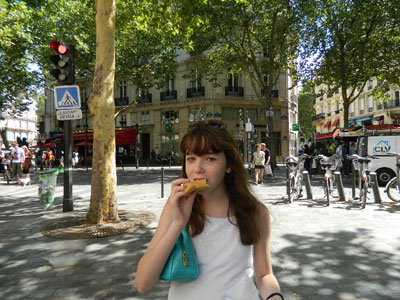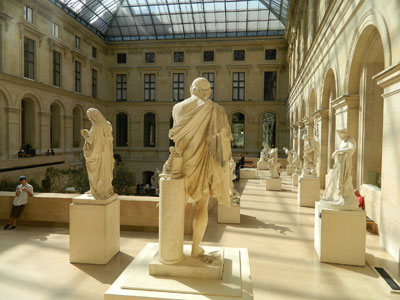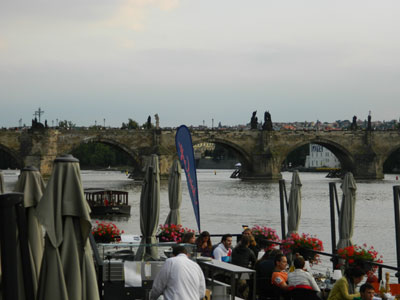Traveling with a teen in Prague and Paris
This article appears on page 32 of the May 2013 issue.
Fred Steinberg; Greenwich, CT
When my wife, Maria, and I took our granddaughter Liana to Europe in August ’12, we thought she would be excited to view the dramatic architecture of old-town Prague, the grandeur of Prague Castle and the splendor of Notre Dame and to sample foie gras, onion soup, duck confit and moules frites at Parisian bistros in the Latin Quarter.
We found, however, that she preferred a tour of the catacombs under Prague’s Old Town Square, a late-night tour of ancient Prague cemeteries, mausoleums and churchyards, feeding the pigeons in the Tuileries Garden and eating the best pastries in Paris.
Welcome to the wonderful world of teen travel, where you throw away about 50% of your pretravel plans and learn to listen to the likes and dislikes of even a very quiet and laid-back member of Gen Z.
Beginning in Prague
We traveled from San Diego to Prague via LOT — a total of 20 hours with stops in Chicago and Warsaw. The airline lived up to its reputation — on time, good food, excellent service and competitively priced.
We stayed three days with friends, on the first morning buying a 48-hour family pass (CZK1,300, or $65) for Prague’s Hop on-Hop off yellow bus, which offers three routes covering 24 stops in and around Prague. The pass included a one-hour cruise on the Vltava River.
We toured Old Town Square, parts of which date back to the 12th century. Its center is dominated by the Old Town Hall Tower and Astronomical Clock, built in the 15th century. The square also houses the impressive late-Gothic Church of Our Lady before Ty´n as well as the sparkling-white St. Nicholas Church and features street artists, performers and musicians.
For lunch, we took the Hop on-Hop off bus to Restaurant Parnas (Smetanovo nábrˇezˇí 1012/2), an Art Deco-style dining, drinking and meeting place for generations of Czech artists, writers and politicians. An excellent 2-course salad or sandwich lunch with beverage can be had for less than CZK350 ($18).
We spent the afternoon at Prague Castle, one of the largest castle complexes in the world. The complex includes the Old Royal Palace; the Basilica of St. George; St. Vitus Cathedral; the 200-foot-high Powder Tower; the lovely castle gardens, and the excellent picture gallery.
Most of the attractions are free except for the towers and galleries. Full-access tickets cost CZK350, with discounts available for students, seniors, children and family groups.
We had dinner at the famous Marina Grosseto restaurant (phone +420 222 316 744), which floats on the Vltava River and offers great views of the Charles Bridge and the well-lit Prague Castle in the distance. The restaurant features pasta, pizza and pastries, and our very good 3-course dinner with wine cost a reasonable CZK600- CZK700. Make reservations well in advance to assure a table on the river side.
The pastry dessert that we had on the terrace and the view from the restaurant were Prague highlights for Liana.
Prague’s darker side
The next day we walked the cobbled streets of Old Town, admiring buildings 500 and more years old. Only parts of the Old Town’s surrounding wall remain, but the ruins include a number of medieval entrances, the most impressive of which is the Powder Tower Gate. We wandered around Charles Square Park, the largest city-center park in Europe, and Celetná Street, a pedestrian lane lined with a wide variety of old houses.
In the afternoon we walked the lively Jewish Quarter, which features many historic buildings, high-end shops, ethnic restaurants and street music. Its most famous structure is the 13th-century Old New Synagogue, built in traditional Gothic style. It is one of the oldest active synagogues in the world.
Late afternoon found us taking the Prague Underground Tour (CZK400, adult). Beginning at the historic Town Hall, the tour takes visitors beneath Prague Square and through the catacombs, cellars and hidden rooms that were built in layers over the years to avoid constant flooding. The rooms feature historic wall paintings and artifacts, statues of murdered royalty and the remains of former prisons and dungeons. The tour ends with a wonderful photo exhibit of late-20th-century and contemporary Prague. Liana gave this tour four stars.
That night we took the “Ghosts and Legends Walking Tour” (CZK300, adult) to experience this fabled, haunted city after dark. We listened to stories of medieval legends — from headsmen and ghosts to ghouls and goblins — while we toured graveyards, church alleys and “haunted spots.” We heard tales of beheadings, drownings, stake burnings and live burials, which were common ways of disposing of one’s enemies in ancient Prague. Liana gave this tour an A-1 rating.
Tickets for both tours can be purchased at the Prague Special Tours office in the Art Passage off Old Town Square. Discounts are available for children, families and students.
For our last night in Prague, we wanted to try the one-year-old Fusion Hotel (Panská 9), which we had heard a great deal about. It’s a funky boutique hotel with a stylish interior, art by contemporary Czech painters and clever poetry and quotations on hall and room walls.
Converted from a warehouse in the city’s newer downtown section, the Fusion features a wide variety of accommodations, from hostel rooms to junior suites, and the rotating lobby bar, 360°. Rates vary, depending on season, from CZK400 per person for a 4-person hostel-style room to junior suites for three at CZK3,500.
Prague to Paris
It was our intention to take the train for the 675-mile trip from Prague to Paris, but because Eastern and Western European trains operate on different rail gauges and were not designed to easily interconnect, the fastest route would have entailed two train changes and a 14-hour trip. We opted instead for a direct flight on Smart Wings Airline, which made the trip in 90 minutes for $110 each.
A half-hour cab ride from Paris’ Charles de Gaulle Airport brought us to a well-furnished studio with sleeping loft in the 8th Arrondissement. Located on a quiet block in a safe neighborhood a block from the Élysée Palace, it was just a 10-minute walk from the Champs Élysées. We found the apartment through a classified ad in ITN. The base price was $1,395 per week.
Our flat had a small kitchen, which was more than well equipped for our light breakfasts. For lunch we usually took food out from or ate in one of the many patisseries, bakeries and sweet shops we covered while researching an article my wife was writing for a food magazine.
Late in the afternoon we would stop at another patisserie and pick up pastries, combining them with the ones left from our lunch stop and taking them back to the flat. There, Maria and Liana would arrange and rearrange our day’s bounty as they took photographs for Maria’s article. Shopping, eating and photographing pastry turned out to be great fun for Liana.
How these two rail-thin women kept from putting on pounds is beyond me, but the activity certainly helped lighten my wallet, as upscale Parisian pastries can run from six to eight euros ($7.50-$10) apiece.
Though we did not find any outstanding local restaurants for dinner, three of the four bistros we tried in the neighborhood served good fare, with 3-course dinners with wine running €25-€35 ($32-$45). They were Cafés Richard and Le Président (49 and 59 av. Franklin Roosevelt) for French food and Café Michael Angelo (87, blvd Haussmann) for Italian.
Exploring Paris
Our first full day was spent exploring our Right Bank neighborhood and locating restaurants, a supermarket, fruit stands, a tabac, Mètro stations, patisseries, boulangeries and other shops we thought we would like to visit in the days ahead.
We found the impressive Neo-Classic Church La Madeleine, with its celebrated organ, nearby, where you can have a 3-course French lunch during the week under its massive dome for €7.50 plus a one-time membership fee (€3). We lunched, however, just a block away at Fauchon, arguably the most famous and among the most expensive epiceries (food shops) in Paris.
At Fauchon’s patisserie, I watched lines of people (mostly tourists, I suspect) purchase €200 to €300 worth of pastries and candies. The most elaborate gift box in the shop was priced at €600, though in the 30 minutes I was there I saw none purchased.
In the afternoon, we walked the nearby Tuileries, admiring the beautifully kept gardens, flowers and shrubs.
We purchased 5-day Mètro passes (€37 each) and found we could access most destinations using the easy-to-follow Mètro system. Late at night, or for the few locations we visited that were not near a Mètro stop, cabs were easy to find at prices similar to those in major US cities.
On our second day, we took the Mètro to the Hôtel de Ville station and wandered from the Île de la Cité to the Eiffel Tower, starting with a long look outside and inside at Notre Dame Cathedral, though we opted to forgo the 387 steps to the top of the tower.
We then shifted from Right Bank to Left, viewing museums, bridges, monuments and historic buildings along the way. We gave close looks to the National Museum of the Middle Ages and Sainte-Chapelle, viewed the Musée d’Orsay and the French Revolution and Asian Arts museums and walked the Pont des Arts bridge, where thousands of “love padlocks” have been hung on the railings — a favorite stop for our teen.
Montmartre
On our third day, we took a fast Mètro ride to Montmartre, known for its barrios and flea and food markets. The area is also home to writers and artists, many of whom display their works on the streets or in street-side studios. The area is dominated by the magnificent, white Basilica of Sacré-Cœur, a Roman Catholic church completed in 1919.
A quick Mètro ride took us to Boulangerie Mairie Délices on rue du Poteau, famous for its buttery chocolate brioches. Together with a baguette and a hunk of cheese from a neighboring fromagerie, we found our way to Parc Monceau for a fun picnic. Liana loved wandering this lovely park and photographing the gardens, statues and a pony corral.
Then it was off to the Champs-Élysées for some serious shopping, the best of which turned out to be just a 10-minute walk away at the famous Galeries Lafayette on blvd Haussmann. The century-old, 2-block-long series of department store segments features the latest high-end clothing and accessories, jewelry, toys, luggage and souvenirs.
For my wife and teen, the store’s highlight was Lafayette Gourmet, filled to the rafters with sweets and savory edibles, which well provided for our late-afternoon snack and their afternoon food-photography project.
The souvenir department also provided some unique gift items, including little bottles of truffle salt and vinegar.
Art and cinema
Day four started out with a long stroll around the Jewish Quarter (“Pletzl” in Yiddish). After all, this was Liana’s bat mitzvah trip. The area features synagogues, large and small, and shops, including the Bazar Suzanne and St. Louis Boulangerie (Liana’s favorite Pletzl stop, of course, though one must wonder what Saint Louis is doing in the Jewish Quarter).
In the early afternoon we visited the nearby Jewish Museum of Art and History (71, rue du Temple), housed in one of the most beautiful mansions in Paris. The museum traces the evolution of the artistic and cultural heritage of the Jewish world, with a special focus on the history of Jews in France expressed through paintings, photographs, sculpture, religious objects, textiles and unique documents.
Then it was off to the Louvre. We avoided the long ticket line by buying a day ticket (€11) beforehand at the Virgin Megastore on the Champs-Élysées.
We planned our museum tour in advance to include some 15 famous paintings and sculptures, including the “Mona Lisa,” “St. John the Baptist” and, our granddaughter’s favorites, “Daniel in the Lion’s Den” and “Dying Slave” (the kid has a dark streak, apparently). She loved the sculpture garden and its giant skylight — ideal for photography.
The following morning started with a visit to the Aquarium de Paris to view a wide variety of sea life, from snails to sharks. The aquarium featured videos shown on a giant screen and mini-theaters showing sea-life animation and National Geographic specials for various ages. One large theater is used for live, interactive shows for younger children and lectures for teens and adults.
Then we went to Les Etoiles du Rex, or The Grand Rex Theatre (1, blvd Poissonnière), the largest cinema in Europe, for a 50-minute, behind-the-scenes tour that included a projection booth, special-effects room and a sound stage where we became “actors” in a short adventure film which we could view and purchase at the end of the tour. Liana thought all of this was very cool.
After a late lunch of salad and pastry, we visited the Musée Rodin, my favorite Paris museum, whose garden contains some of the world’s greatest sculptures. Liana quickly took to carefully photographing “The Thinker,” “The Burghers of Calais,” “Eve,” “Meditation” and, her favorite, “The Gates of Hell.” The Jardin d’Orphée provided a welcome afternoon break from a busy day.
A final day in Paris
We started our final full day with a visit to the 14th-century Conciergerie, part of the Palace of Justice and Prison complex, which Liana was very taken with.
We toured the prisoners’ gallery, where inmates could congregate; the women’s courtyard, where they bathed and washed their clothes; the grooming room, where condemned prisoners were stripped of personal belongings before execution; the series of cells divided into sections for paupers, payers and high-class “guests,” and Marie Antoinette’s cell, where she stayed before being beheaded. A 19th-century guillotine display particularly appealed to our teen’s dark side.
Next we walked through the Latin Quarter, enjoying the street scene of kiosks, street performers, funky shops and the lovely Luxembourg Gardens. We gazed at the Panthéon, the Church of St. Stephen (Saint-Étienne-du-Mont) and the Curie Museum. Unfortunately, as we were there during August, vacation time in Paris, the Sorbonne was closed.
Fortified by a street lunch of crêpes, we headed to the 6th Arrondissement to experience a residential neighborhood and find À la Mère de Famille, a chocolate-and-confectionary shop founded in 1761. After some sampling, we purchased caramels and bars of dark and milk chocolates studded with nuts and dusted with cocoa.
At the nearby Poilâne bakery, we purchased a fourth of their giant, signature, stone-ground-flour sourdough bread for our final breakfast the following day.
As we had toured catacombs under old-town Prague and those at the Louvre, where they link a number of the old and new buildings, we skipped the catacombs of Paris, which feature a collection of human bones from the 17th to 19th centuries. We also bypassed the sewer tour, which is really a short walk along some of the unused water tunnels beneath the city — the world’s first and longest underground city water system, It has very limited summer hours.
For our final Parisian evening we took a late-night boat for a 75-minute trip on the Seine, cruising from around the Île de la Cité to past the Eiffel Tower, which puts on a dazzling light show hourly after dark. The cost was €11.50 each for adults and €5.50 for children 4 to 12. It was an impressive finale to our teen’s first visit to the City of Light, and she loved it!

